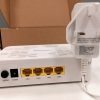Study Claims UK Broadband Speeds Slow by 27 Percent During Heatwaves

A new study of over 380,000 web-based consumer broadband speed tests (recorded over the past 12-months), which was conducted by comparison site Broadband Genie, claims to have identified that broadband download speeds can slow down by up to 8% and uploads by up to 27% on the hottest days of the year (usually heatwaves).
The study was conducted by taking the average download and upload broadband speed from typically the hottest part of the day (11:00 – 15:30). This was then compared to broadband speeds recorded on the five hottest days of the year in the same hours of the day.
Upload speeds took the biggest tumble, dropping 27% on the hottest day, recorded in Brogdale, Kent. On the same day, download speeds were also 8% slower. On average, upload speeds declined by a tenth (10%) and download speeds dropped 3% vs. speeds on an average day.
Advertisement
However, it’s worth pointing out that the issue here is likely to be less down to your broadband connection and more with your router, since the chipset (CPU) may automatically choose to throttle back its performance as part of thermal management during very hot days (i.e. helping to avoid a hardware crash) – particularly if the device is under heavy load at the same time.
However, in that sense, it may not be entirely fair of the study to describe this as being due to “broadband speeds“, since the slowdown is less likely to be caused by your ISP and is more of a local network issue. “Our research shows hotter temperatures consistently take the edge off your broadband speed. The main weakness is your home broadband router. If the internal components get too hot and overheat, it will slow down or even cut out. If surfers aren’t careful, it could grind your connection to a halt,” said Alex Tofts, Strategist at Broadband Genie.
Table: Broadband speed on the hottest days of a year
| Hottest temperature recorded | Temperature (°C) | Download speed change vs. overall average | Upload speed change vs. overall average |
| Brogdale, Kent | 35.6 | -8% | -27% |
| Heathrow, London | 32.7 | 0% | -3% |
| Wisley, Surrey | 32.6 | -1% | -2% |
| Coningsby, Lincolnshire | 32.2 | -5% | -11% |
| Chertsey, Surrey | 32.2 | 1% | -9% |
As we’ve said before (here), most router manufactures are aware of thermal management and design their hardware to operate at temperatures of up to around 40c (varying a bit between manufacturers). Sadly, an overheating broadband ISP router is something that can happen, although even many of the devices with a stated tolerance of up to 40c may actually continue to function for a handful of degrees past that point.
Advertisement
However, experiences do vary a lot, and we should point out that your mobile phones, laptops, game consoles, tablets and other electronics may also run into their own issues (i.e. the router may not be the only source of performance problems that can impact your network).
Sadly, the study doesn’t date its temperature recordings or include a technology split, since it would have been interesting to know whether FTTP connections are just as likely to suffer from such issues as copper-based (ADSL, FTTC etc.) ones. If the primary cause is within the end-users network, then the answer may be yes. But equally, full fibre infrastructure should be more resilient since a lot of the related processing hardware will be retained back at the air-conditioned exchange/data centre (some areas may also place related networking kit inside more exposed local street cabinets).
On the other hand, it’s worth noting that the headline figures given in the study (8% and 27%) are clearly location specific. But in other areas the results show only a small to modest change, with Heathrow being largely unimpacted for downstream traffic and Chertsey actually showing a gain of 1%. Most of the figures show fluctuations that are thus a bit too small for drawing credible conclusions and, in fairness, the UK isn’t exactly a particularly “hot” country, so far as the world goes.
Finally, we should point out that we all live in different buildings, where the resilience to internal temperature rise will also differ – often significantly. As a result, the outside temperature measurement on a specific day does not tell us the whole story.
Advertisement
Mark is a professional technology writer, IT consultant and computer engineer from Dorset (England), he also founded ISPreview in 1999 and enjoys analysing the latest telecoms and broadband developments. Find me on X (Twitter), Mastodon, Facebook, BlueSky, Threads.net and Linkedin.






















































Electrical noise generally scales with heat – Johnson-Nyquist noise. Much of that noise manifests in the electromagnetic spectrum. Your router may do some thermal management, but the SNR (signal to noise ratio) in WiFi signals worsens with temperature as all the electrical devices in your home make a little bit more noise as they get hotter.
The resistance of the copper conductor also increases with temperature.
Other factors could include routing equipment in hot cabinets throttling so as to not overheat.
Very minimally, Darren. You can find graphs and formulae online. At VDSL frequencies and FTTC loop lengths the change is very small. Nearly all the increased loss comes from cable joints.
I think a lot of copper lines benefit from the dry weather. My mums is nearly 2km long and definitely sees an increase of ~5Mb in the summer.
NB I know nothing about electronics 🙂
Probably down to dry joints mostly.
Sounds like the line has some dodgy joints in it, so performs worse in wet weather.
Load of nonsense. Needs a proper technical explanation for the complete network connection.
What did you have in mind for the complete explanation, please?
It’s going to be a home or access network thing.
It’s going to be heavily influenced by RF noise from air conditioning messing with DoCSIS, DSL and WiFi alongside some of the more dubious Virgin Media cabinets getting too warm.
Some CPE getting too warm. Across the entire network connection once it’s digital and riding over fibre it’s good to go.
Or they could be sat in the Garden using WiFi and farther from the router when doing said speed tests.
Could simply be more people are sat outside in their gardens and they are testing if their Wi-Fi is still good enough and it slower as they further away out in their gardens, or more people out in parks using more mobile data, so it slows down due to demand.
I suppose its a novelty not being a Zen Survey for the free marketing 🙂
Openreach SoGfast reduced downlink from 271 to 211 and uplink from 37 to 30 in hot summer season. Sogfast are lots better in the coldest winter season. No longer on Sogfast 330/50 downgraded to 160/30.
A study full of hot air.
When ever this reports emerge during hot weather I run a speed test, I’ve never seen any downgrade in my connection, just run one and all expected speeds,can anyone explain?
You’re probably connected via Ethernet on FTTP, which isn’t affected by hot weather that much if at all.
30 degrees outside, just done a speed test, and it is slightly faster than the last one I did, Full fibre on Zzoomm. I have not long cycle past their large cabinet and the fan inside seemed to be going crazy, if that stopped, we would be in trouble.
It is warm, be glad when it starts to cool down.
Alex Tofts is right that router overheating is the main cause but other causes include increased resistance in copper wires, increased congestion and overheating of active components in cabinets such as DSLAMs, optical nodes and amplifiers.
There is negligible change in resistance between 20 and 30deg.
@The Facts, you would be surprised, especially between 0 and 30C and on poor copper wiring!
The changes are almost entirely at the cable joints not resistance on the copper wire itself, Will. Joints expand, cables not as much, connection isn’t as flush so can be an increase in attenuation. Think that’s what Facts was referring to.
Same story on cable networks too. Cabinets cook, connectors in them expand, conductor in the coax is less flush with the contact point in the connector.
The impact of the actual temperature change on the cable itself is tiny. Cable with surface temperature of 40 degrees has about 4% higher loss than one at 20 degrees and that’s at about a GHz if I recall, higher than cable in the UK goes. At DSL frequencies of 17 MHz and under way smaller. Even at G.fast frequencies just above 100 MHz not that big of a deal given the short cable runs.
@Polish Poler: Those figures are for ideal conditions. The cabling will typically have been in situ for quite some time and the wear and tear over the years will magnify the overall impact.
Yes, the source could have been more nuanced on the claims and more open with the details.
Overhead copper cable runs are far more susceptible to heating than are buried cables. The latter suffer more significantly from water ingress.
Hub devices can manage throttling based on device temperatures, but I have not seen this kick in. More likely, where these changes are observed, the provider’s router is being proactively managed to defend the quality of service metrics.
Please elaborate on the provider’s router being proactively managed to preserve quality of service metrics, I have never heard of this.
@Polish Poler: I used the incorrect wording.
Not surprising if you are still using a copper-based service such as ADSL or VDSL, fibre is not affected by heat so much if at all. I remember in the VDSL days that the sync speed would be lower on hot days if a resync happened to occur then.